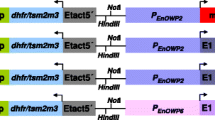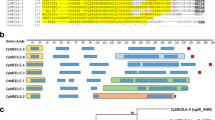Abstract
The precocious lines of Eimeria spp. have unique phenotypes. However, the genetic basis of the precocious phenotype is still poorly understood. The identification of Eimeria genes controlling the precocious phenotype is of immense importance in the fight against coccidiosis. In the present study, a novel gene of Eimeria maxima was cloned using rapid amplification of cDNA ends (RACE) based on the expressed sequence tag (EST). Homologous genes were also found in Eimeria tenella and Eimeria acervulina. Alignment of the amino acid sequences from E. tenella, E. maxima, and E. acervulina showed 80–86 % identity, demonstrating a conserved protein in different Eimeria spp. This gene, designated Eimeria-conserved protein (ECP), contained 235 amino acids with a predicted molecular mass of 25.4 kDa and had 100 % identity with one annotated protein from E. maxima (Emax_0517). Real-time PCR and Western blot analysis revealed that the expression of ECP at mRNA and protein level in E. tenella is developmentally regulated. Messenger RNA levels from the ECP gene were higher in sporozoites than in other developmental stages (unsporulated oocysts, sporulated oocysts, and second-generation merozoites). Expression of ECP protein was detected in unsporulated oocysts, increased in abundance in sporulated oocysts, and was most prominent in sporozoites. Thereafter, the level of the ECP protein decreased, and no ECP-specific protein was detected in second-generation merozoites. Immunostaining with anti-rECP indicated that ECP is highly concentrated in both refractile bodies (RB) of free sporozoites, but is located at the apical end of the sporozoites after invasion of DF-1 cells. The specific staining of the ECP protein becomes more intense in trophozoites and immature first-generation schizonts, but decreases in mature first-generation schizonts. Inhibition of the function of ECP using specific antibodies reduced the ability of E. tenella sporozoites to invade host cells. Compared with the parent strain, both mRNA and protein expression levels in the sporulated oocyst were downregulated in the precocious line of E. tenella. These results suggest that ECP may be involved in invasion and development of the first-generation merogony stage of E. tenella. Findings of downregulation of ECP mRNA and protein expression in the precocious line enrich the study of the precocious phenotype of Eimeria.







Similar content being viewed by others
References
Chen T, Zhang W, Wang JM, Dong HT, Wang M (2008) Eimeria tenella: analysis of differentially expressed genes in the monensin- and maduramicin-resistant lines using cDNA array. Exp Parasitol 119:264–271
Dalloul RA, Lillehoj HS (2005) Recent advances in immune modulation and vaccination strategies against coccidiosis. Avian Dis 49:1–8
Danforth HD, Augustine PC (1989) Eimeria tenella: use of a monoclonal antibody in determining the intracellular fate of the refractile body organelles and the effect on in vitro development. Exp Parasitol 68:1–7
de Venevelles P, François Chich J, Faigle W, Lombard B, Loew D, Péry P, Labbé M (2006) Study of proteins associated with the Eimeria tenella refractile body by a proteomic approach. Int J Parasitol 36:1399–1407
Del Cacho E, Gallego M, López-Bernad F, Quílez J, Sánchez-Acedo C (2005) Differences in Hsp70 expression in the sporozoites of the original strain and precocious lines of Eimeria tenella. J Parasitol 91:1127–1131
Dong H, Lin JJ, Han HY, Jiang LL, Zhao QP, Zhu SH, Huang B (2011) Analysis of differentially expressed genes in the precocious line of Eimeria maxima and its parent strain using suppression subtractive hybridization and cDNA microarrays. Parasitol Res 108:1033–1140
Doran DJ (1982) Behavior of coccidia in vitro. In: Long PL (ed) The Biology of the Cocidia. University Park Press, Baltimore, pp 229–285
Entzeroth R, Mattig FR, Werner-Meier R (1998) Structure and function of the parasitophorous vacuole in Eimeria species. Int J Parasitol 28:1015–1018
Fayer R (1969) Refractile body changes in sporozoites of poultry coccidia in cell culture. Proc Helminthol Soc Wash 36:224–231
Fayer R, Hammond DM (1969) Morphological changes in Eimeria bovis sporozoites during their first day in cultured mammalian cells. J Parasitol 55:398–401
Fetterer RH, Jenkins MC, Miska KB, Barfield RC (2007) Characterization of the antigen SO7 during development of Eimeria tenella. J Parasitol 93:1107–1113
Gallego Edel C, Lopez-Bernad F, Sánchez-Acedo C, Quilez J (2007) Flotillin-1 localization on sporozoites of Eimeria tenella. J Parasitol 93:197–198
Hammond DM, Speer CA, Roberts W (1970) Occurrence of refractile bodies in merozoites of Eimeria species. J Parasitol 56:189–191
Han JF, Huang B, Dong H, Yu CF, Han HY, Zhao QP, Jiang LL, Wang X (2008) Selection and characteristics of a precocious strain of Eimeria tenella. J Fudan Univ (Nat Sci) 3:380–386 (in Chinese)
Han HY, Lin JJ, Zhao QP, Dong H, Jiang LL, Xu MQ, Zhu SH, Huang B (2010) Identification of differentially expressed genes in early stages of Eimeria tenella by suppression subtractive hybridization and cDNA microarray. J Parasitol 96:95–102
Han HY, Zhu SH, Jiang LL, Li Y, Dong H, Zhao QP, Kong CL, Huang B (2013) Molecular characterization and analysis of a novel calcium-dependent protein kinase from Eimeria tenella. Parasitology 140:746–755
Huang B, Zhao QP, Wu XZ, Shi TW, Chen ZG (1993) Study on the identification and pathogenicity of the pure species of Eimeria tenella. Shanghai J Anim Husb Vet Med 3:18–20 (in Chinese)
Huang B, Shi TW, Zhao QP, Wu XZ, Chen ZG (1994) Study on the identification and pathogenicity of the pure species of Eimeria acervulina. Chin J Vet Sci Tech 9:23–24 (in Chinese)
Huang B, Shi TW, Wu XZ, Zhao QP, Chen ZG (1995) Study on the identification and pathogenicity of the pure species of Eimeria maxima. Chin J Vet Parasitol 4:12–14 (in Chinese)
Iida K, Nishimura I (2002) Gene expression profiling by DNA array technology. Crit Rev Oral Biol Med 13:35–50
Jahn D, Matros A, Bakulina AY, Tiedemann J, Schubert U, Giersberg M, Haehnel S, Zoufal K, Mock HP, Kipriyanov SM (2009) Model structure of the immunodominant surface antigen of Eimeria tenella identified as a target for sporozoite-neutralizing monoclonal antibody. Parasitol Res 105:655–668
Jean L, Grosclaude J, Labbe M, Tomley F, Pery P (2000) Differential localization of an Eimeria tenella aspartyl proteinase during the infection process. Int J Parasitol 30:1099–1107
Jeffers TK (1975) Attenuation of Eimeria tenella through selection for precociousness. J Parasitol 61:1083–1090
Jeffers TK, Shirley MW (1982) Genetic, specific, and intraspecific variation. In: Long PL (ed) The biology of the coccidia. University Park Press, Baltimore, pp 63–100
Jiang LL, Lin JJ, Han HY, Zhao QP, Dong H, Zhu SH, Huang B (2011) Identification and partial characterization of a serine protease inhibitor (serpin) of Eimeria tenella. Parasitol Res 110:865–874
Jiang LL, Lin JJ, Han HY, Dong H, Zhao QP, Zhu SH, Huang B (2012) Identification and characterization of Eimeria tenella apical membrane antigen-1(AMA1). PLoS One 7:e41115
Johnson J, Reid WM, Jeffers TK (1979) Practical immunization of chickens against coccidiosis using an attenuated strain of Eimeria tenella. Poult Sci 58:37–41
Kim DK, Lillehoj H, Min W, Kim CH, Park MS, Hong YH, Lillehoj EP (2011) Comparative microarray analysis of intestinal lymphocytes following Eimeria acervulina, E. maxima, or E. tenella infection in the chicken. PLoS One 6:e27712
Lee SH, Lillehoj HS, Jang SI, Kim DK, Ionescu C, Bravo D (2010) Effect of dietary Curcuma, Capsicum and Lentinus on enhancing local immunity against Eimeria acervulina infection. J Poult Sci 47:89–95
Lemgruber L, Lupetti P (2012) Crystalloid body, refractile body, and virus-like particles in Apicomplexa: what is in there? Parasitology 139:285–293
Licois D, Coudert P, Bahagia S (1989) Some biological characteristics of a precocious line of Eimeria intestinalis. In: INRA (ed) Coccidia and intestinal coccidiomorphs. 5th Int Cocidiosis Conf, Tours. INRA, pp503-508
Licois D, Coudert P, Boivin M, Drounet-Viard F, Provot F (1990) Selection and characterization of a precocious line of Eimeria intestinalis, an intestinal rabbit coccidium. Parasitol Res 76:192–198
Licois D, Coudert P, Drouet-Viard F, Boivin M (1994) Eimeria media: selection and characterization of a precocious line. Parasitol Res 80:48–52
Licois D, Coudert P, Drouet-Viard F, Boivin M (1995) Eimeria magna: pathogenicity, immunogenicity and selection of a precocious line. Vet Parasitol 60:27–35
Pakandl M, Licois D, Coudert P (2001) Electron microscopy study on sporocysts and sporozoites of parental strains and precocious lines of rabbit coccidia Eimeria intestinalis, E. media, and E. magna. Parasitol Res 87:63–66
Peroval M, Pery P, Labbe M (2006) The heat shock protein 90 of Eimeria tenella is essential for invasion of host cell and schizont growth. Int J Parasitol 36:1205–1215
Podell S, Gribskov M (2004) Predicting N-terminal myristoylation sites in plant proteins. BMC Genomics 5:37
Roberts WL, Hammond DM (1970) Ultrastructural and cytologic studies of the sporozoites of four Eimeria species. J Protozool 17:76–86
Roberts WL, Hammond DM, Anderson LC, Speer CA (1970) Ultrastructural study of schizogony in Eimeria callospermophili. J Protozool 17:584–592
Shirley MW (1995) Eimeria species and strains of chickens. In Biotechnology Guidelines on Techniques in Coccidiosis Research (ed. Coudert P, Eckert J, Braun R, Shirley MW), pp. 9–10. The European Commission DGXII, Luxembourg City, Luxembourg
Shirley MW, Bedrník P (1997) Live attenuated vaccines against avian coccidiosis: success with precocious and egg-adapted lines of Eimeria. Parasitol Today 13:481–484
Shirley MW, Harvey DA (2000) A genetic linkage map of the Apicomplexan protozoan parasite Eimeria tenella. Genome Res 10:1587–1593
Shirley MW, Smith AL, Blake DP (2007) Challenges in the successful control of the avian coccidia. Vaccine 25:5540–5547
Speer CA, Hammond DM (1970) Nuclear divisions and refractile-body changes in sporozoites and schizonts of Eimeria callospermophili in cultured cells. J Parasitol 56:461–467
Tomley FM (1997) Techniques for isolation and characterization of apical organelles from Eimeria tenella sporozoites. Methods 13:171–176
Xie MQ, Gilbert JM, Fuller AL, McDougald LR (1990) A new method for purification of Eimeria tenella merozoites. Parasitol Res 76:566–569
Acknowledgments
This work was supported by grants from the National Science Foundation of China (grant no. 31272557), the key scientific and technological projects of Science and Technology Commission of Shanghai Municipality, China (grant no. 12391902200), and Central Public Welfare Research Institutions and Basic Scientific Research Business Expenses (grant no. 2012JB14). We thank Zhixin Zhao, Beiming Zhang, and Dingtao Liu for their excellent technical assistance.
Author information
Authors and Affiliations
Corresponding author
Rights and permissions
About this article
Cite this article
Dong, H., Wang, Y., Han, H. et al. Identification and characterization of an Eimeria-conserved protein in Eimeria tenella . Parasitol Res 113, 735–745 (2014). https://doi.org/10.1007/s00436-013-3703-x
Received:
Accepted:
Published:
Issue Date:
DOI: https://doi.org/10.1007/s00436-013-3703-x




